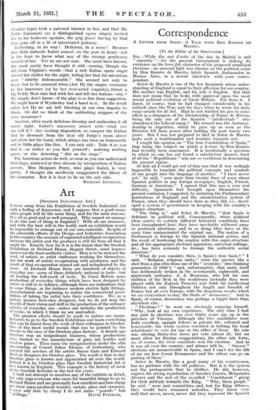Art
[SWEDISH INDUSTRIAL ART.] I WENT away from the Exhibition of Swedish Industrial Art with a feeling of depression, and I suppose that a good many other people will do the same thing, and for the same reasons. It h all so good and so well arranged. Why cannot we manage to do this sort of thing in England ? With all our resources, and with the best will in the world, such an exhibition would be impossible to arrange out of our own materials. In spite of the admirable efforts of the Design and Industries Association in this country the amount of organised intelligent co-operation between the artist and the producer is still far from all that it might be. Exactly how far it is is the lesson that the Swedish Exhibition at Dorland House, Regent Street, must impress upon even the least aesthetic visitor. Here is to be seen not the work of artists or artist craftsmen working for themselves, but the work of artists co-operating with producers, and the result of that co-operation turned out and reduplicated by the score. At Dorland House there are hundreds of objects of everyday use—some of them definitely national in taste—but all bearing the hall-mark of taste. In Great Britain mass production of everyday things which have been designed by artists is still in its infancy, although there are indications that in some things, as for instance modern electric light fittings, manufacturers are beginning to realize the commercial possi- bilities of taking the artist into their confidence. We, as a nation, possess first-class designers, but we do not reap the benefit of their vision and skill in the production of the ordinary articles of everyday use—unless one includes the production of books, in which I think we are unrivalled.
The greatest efforts should be made to induce our manu- facturers to go to the Swedish Exhibition and learn everything that can be learnt from the work of their colleagues in Sweden. One of the most useful morals that can be pointed by the Swedes is the case of the Orrefors glass factory. A decade ago Orrefors was an insignificant business, whose productions were limited to the manufacture of glass ink bottles and window panes. Then came the reorganization under the able directorship of Consul Johan Ekman, of Gottenburg, who enlisted the services of the artists Simon Gate and Edward }laid as designers for Orrefors glass. The result is that to-day Orrefors glass is known and appreciated all over the world. Indeed it is by Orrefors glass that Swedish Industrial Art is best known in England. This example is the history of most of the Swedish factories in the last ten years.
I shall not attempt to mention any of the exhibits in detail, but only urge everyone who cares for beautiful things to go to Borland Rouse and see personally how excellent and how cheap are these mass-produced textiles, metals, glass and ceramics. I must add that by cheap I do not mean " pounds " but


















































 Previous page
Previous page